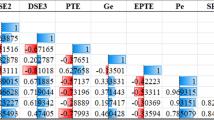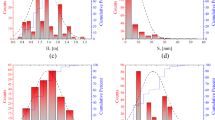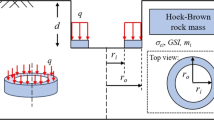Abstract
In geotechnical engineering, accurately estimating the ultimate bearing capacity (\({Q}_{u}\)) of rock-socketed piles remains a crucial challenge. This study introduces a methodology that integrates advanced optimization algorithms, specifically Dandelion Optimization (DO) and the Crystal Structure Algorithm (CryStal), with Support Vector Regression (SVR) to enhance predictive capabilities. Three distinct models—SVDO, SVCS, and a hybrid SVR model—are developed through this integration. The core of this predictive framework is SVR, known for its efficacy in capturing intricate non-linear relationships between input variables and the ultimate bearing capacity of rock-socketed piles. To improve predictive accuracy, DO strategically adjusts hyperparameters to emulate the growth and dispersal patterns of dandelion seeds, while CryStal delicately optimizes SVR parameters inspired by crystalline atomic structures. The resulting models offer valuable insights for precisely predicting the ultimate bearing capacity of rock-socketed piles in geotechnical engineering. Among these, SVCS stands out with an exceptional R2 value of 0.997, indicating an outstanding fit to the data, and the lowest Root Mean Squared Error (RMSE) at 930.7, underscoring its unparalleled predictive accuracy. In conclusion, this study presents an innovative approach within geotechnical engineering for the precise estimation of the ultimate bearing capacity of rock-socketed piles. The insights gained contribute significantly to considerations of stability and safety in construction projects, emphasizing a multidisciplinary approach beyond artificial intelligence.














Similar content being viewed by others
References
Akbari Garakani A, Heidari B, Mokhtari Jozani S, Ghasemi-Fare O (2022) Numerical and analytical study on axial ultimate bearing capacity of fixed-head energy piles in different soils. Int J Geomech 22(1):4021258
Akbarzadeh MR, Ghafourian H, Anvari A, Pourhanasa R, Nehdi ML (2023) Estimating compressive strength of concrete using neural electromagnetic field optimization. Materials 16(11):4200
Bahmed IT, Khatti J, Grover KS (2024) Hybrid soft computing models for predicting unconfined compressive strength of lime stabilized soil using strength property of virgin cohesive soil. Bull Eng Geol Env 83(1):46
Bell FG (1996) Lime stabilization of clay minerals and soils. Eng Geol 42(4):223–237
Bozozuk M and Bozozuk M (1981) Bearing capacity of pile preloaded by downdrag
Chen W, Sarir P, Bui X-N, Nguyen H, Tahir MM, Jahed Armaghani D (2020) Neuro-genetic, neuro-imperialism and genetic programing models in predicting ultimate bearing capacity of pile. Eng Comput 36:1101–1115
Coyle HM, Castello RR (1981) New design correlations for piles in sand. J Geotech Eng Div 107(7):965–986
Coyle HM, Bartoskewitz RE and Berger WJ (1973) Bearing capacity prediction by wave equation analysis–state of the art
Daniel C, Khatti J, Grover KS (2024) Assessment of compressive strength of high-performance concrete using soft computing approaches. Comput Concr 33(1):55
Farooqui SA, Shees MM, Alsharekh MF, Alyahya S, Khan RA, Sarwar A, Islam M, Khan S (2021) Crystal Structure Algorithm (CryStAl) based selective harmonic elimination modulation in a cascaded H-bridge multilevel inverter. Electronics 10(24):3070
Fellenius BH (1989) Prediction of pile capacity. Predicted and observed axial behavior of piles: results of a pile prediction symposium, 286–295
Gunn SR (1998) Support vector machines for classification and regression. ISIS Tech Report 14(1):5–16
Haykin S (2009) Neural networks and learning machines, 3/E. Pearson Education India
Hosseini S, Khatti J, Taiwo BO, Fissha Y, Grover KS, Ikeda H, Pushkarna M, Berhanu M, Ali M (2023) Assessment of the ground vibration during blasting in mining projects using different computational approaches. Sci Rep 13(1):18582
Jamhiri B, Xu Y, Jalal FE, Chen Y (2023a) Hybridizing neural network with trend-adjusted exponential smoothing for time-dependent resistance forecast of stabilized fine sands under rapid shearing. Transport Infrastruct Geotechnol 10(1):62–81. https://doi.org/10.1007/s40515-021-00198-z
Jamhiri B, Xu Y, Shadabfar M, Costa S (2023b) Probabilistic machine learning for predicting desiccation cracks in clayey soils. Bull Eng Geol Env 82(9):355. https://doi.org/10.1007/s10064-023-03366-2
Jamhiri B, Xu Y, Jalal FE, Chen Y (2021) Hybridizing neural network with trend-adjusted exponential smoothing for time-dependent resistance forecast of stabilized fine sands under rapid shearing. Transport Infrastruct Geotechnol 10:1–20
Janbu N (1976) Static bearing capacity of friction piles. Sechste Europaeische Konferenz Fuer Bodenmechanik Und Grundbau, 1
Khanmohammadi M, Armaghani DJ, Sabri Sabri MM (2022) Prediction and optimization of pile bearing capacity considering effects of time. Mathematics 10(19):3563
Khatti J, Grover K (2022a) A study of relationship among correlation coefficient, performance, and overfitting using regression analysis. Int J Sci Eng Res 13:1074–1085
Khatti J, Grover KS (2022c) Determination of suitable hyperparameters of artificial neural network for the best prediction of geotechnical properties of soil. Int J Res Appl Sci Eng Technol 10(5):4934–4961
Khatti J, Grover KS (2023a) A scientometrics review of soil properties prediction using soft computing approaches. Arch Comput Methods Eng. https://doi.org/10.1007/s11831-023-10024-z
Khatti J, Grover KS (2023b) Estimation of intact rock uniaxial compressive strength using advanced machine learning. Transport Infrastruct Geotechnol. https://doi.org/10.1007/s40515-023-00357-4
Khatti J, Grover KS, Kim H-J, Mawuntu KBA, Park T-W (2024) Prediction of ultimate bearing capacity of shallow foundations on cohesionless soil using hybrid lstm and rvm approaches: an extended investigation of multicollinearity. Comput Geotech 165:105912
Khatti J and Grover KS (2022b) Application of artificial intelligence in geotechnical engineering: a review. Techno-Societal 2016, international conference on advanced technologies for societal applications, 77–85.
Khatti J, Jangid AK and Grover KS (2020) A review: applications of machine intelligence in civil engineering. National Conference on Resilient Infrastructure-NCRI
Khatti J, Samadi H, Grover KS (2023) Estimation of settlement of pile group in clay using soft computing techniques. Geotech Geol Eng 42:1–32
Kisi O, Parmar KS (2016) Application of least square support vector machine and multivariate adaptive regression spline models in long term prediction of river water pollution. J Hydrol 534:104–112
Lee I-M, Lee J-H (1996) Prediction of pile bearing capacity using artificial neural networks. Comput Geotech 18(3):189–200
Li L-L, Chang Y-B, Tseng M-L, Liu J-Q, Lim MK (2020) Wind power prediction using a novel model on wavelet decomposition-support vector machines-improved atomic search algorithm. J Clean Prod 270:121817
Luenberger DG, Ye Y (1984) Linear and non-linear programming, vol 2. Springer
Mahesh B (2020) Machine learning algorithms—a review. Int J Sci Res (IJSR) 9:381–386
Maizir H, Kassim KA (2013) Neural network application in prediction of axial bearing capacity of driven piles. Proc Int Multiconf Eng Comput Sci 1:13–15
Masoumi F, Najjar-Ghabel S, Safarzadeh A, Sadaghat B (2020) Automatic calibration of the groundwater simulation model with high parameter dimensionality using sequential uncertainty fitting approach. Water Supply 20(8):3487–3501. https://doi.org/10.2166/ws.2020.241
Meenakshi M (2020) Machine learning algorithms and their real-life applications: a survey. In: Proceedings of the International Conference on Innovative Computing and Communications (ICICC)
Meyerhof GG (1976) Bearing capacity and settlement of pile foundations. J Geotech Eng Div 102(3):197–228
Momeni E, Maizir H, Gofar N, Nazir R (2013) prediction of axial bearing capacity of driven piles in granular. Jurnal Teknologi 61(3):15–20
Momeni E, Nazir R, Armaghani DJ, Maizir H (2014) Prediction of pile bearing capacity using a hybrid genetic algorithm-based ANN. Measurement 57:122–131
Murlidhar BR, Sinha RK, Mohamad ET, Sonkar R, Khorami M (2020) The effects of particle swarm optimisation and genetic algorithm on ANN results in predicting pile bearing capacity. Int J Hydromechatron 3(1):69–87
Paik K, Salgado R (2003) Determination of bearing capacity of open-ended piles in sand. J Geotech Geoenviron Eng 129(1):46–57
Pham TA, Vu H-LT (2021) Application of ensemble learning using weight voting protocol in the prediction of pile bearing capacity. Math Probl Eng 2021:1–14
Pham TA, Ly H-B, Tran VQ, Giap LV, Vu H-LT, Duong H-AT (2020) Prediction of pile axial bearing capacity using artificial neural network and random forest. Appl Sci 10(5):1871
Randolph MF, Wroth CP (1978) Analysis of deformation of vertically loaded piles. J Geotech Eng Div 104(12):1465–1488
Rezazadeh S, Eslami A (2017) Empirical methods for determining shaft bearing capacity of semi-deep foundations socketed in rocks. J Rock Mech Geotech Eng 9(6):1140–1151
Serrano A, Olalla C (1994) Ultimate bearing capacity of rock masses. Int J Rock Mech Min Sci Geomech Abstracts 31(2):93–106
Sridharan A, Nagaraj HB (2005) Plastic limit and compaction characteristics of finegrained soils. Proc Inst Civ Eng Ground Improve 9(1):17–22
Talatahari S, Azizi M, Tolouei M, Talatahari B, Sareh P (2021) Crystal structure algorithm (CryStAl): a metaheuristic optimization method. IEEE Access 9:71244–71261
Thomas JC, Natarajan AR, Van der Ven A (2021) Comparing crystal structures with symmetry and geometry. NPJ Comput Mater 7(1):164
Ulusay R, Aydan Ö, Erguler ZA, Ngan-Tillard DJM, Seiki T, Verwaal W, Sasaki Y and Sato A (2015) ISRM suggested method for the needle penetration test. The ISRM Suggested Methods for Rock Characterization, Testing and Monitoring: 2007–2014, 143–155
Vapnik V, Golowich S and Smola A (1996) Support vector method for function approximation, regression estimation and signal processing. Adv Neural Inf Process Syst 9
Wang H, Lei Z, Zhang X, Zhou B and Peng J (2016) Machine learning basics. Deep Learn 98–164
Zhang F and O'Donnell LJ (2020) Support vector regression. In: Machine learning (pp 123–140). Elsevier
Zhao S, Zhang T, Ma S, Chen M (2022) Dandelion Optimizer: a nature-inspired metaheuristic algorithm for engineering applications. Eng Appl Artif Intell 114:105075
Zhou Z-H (2021) Machine learning. Springer Nature
Author information
Authors and Affiliations
Contributions
Rongjun You: writing—original draft preparation, conceptualization, supervision, project administration. Huijun Mao: methodology, software, validation, formal analysis.
Corresponding author
Ethics declarations
Conflict of interest
The authors declare no competing interests.
Additional information
Publisher's Note
Springer Nature remains neutral with regard to jurisdictional claims in published maps and institutional affiliations.
Appendix
Appendix
Test Dataset | |||||
|---|---|---|---|---|---|
Lp/D | Ls/Lr | N_SPT | UCS | Hr | Qu |
14.77 | 7.43 | 157.66 | 59.86 | 0.00 | 17,518.25 |
5.42 | 1.71 | 140.15 | 62.73 | 0.00 | 15,693.43 |
49.90 | 1.20 | 0.00 | 0.00 | 1.2 | 10,360 |
14.61 | 5.71 | 119.71 | 34.53 | 0.00 | 32,481.75 |
10.96 | 4.57 | 140.15 | 57.55 | 0.00 | 32,116.79 |
31.56 | 19.43 | 21.90 | 29.93 | 0.00 | 41,605.84 |
46.36 | 8.36 | 0.00 | 0.00 | 8.36 | 9000 |
8.47 | 1.71 | 132.85 | 67.34 | 0.00 | 13,868.61 |
9.89 | 0.86 | 108.03 | 49.50 | 0.00 | 12,408.76 |
13.94 | 3.43 | 11.68 | 36.26 | 0.00 | 23,722.63 |
58.00 | 6.50 | 0.00 | 0.00 | 6.5 | 10,000 |
27.3 | 0.80 | 0.00 | 0.00 | 0.8 | 8000 |
55.96 | 8.08 | 0.00 | 0.00 | 8.08 | 7600 |
11.69 | 4.29 | 132.85 | 48.35 | 0.00 | 13,868.61 |
12.99 | 13.43 | 2.92 | 25.90 | 0.00 | 34,671.53 |
72.64 | 8.98 | 0.00 | 0.00 | 8.08 | 8073 |
22.81 | 0.52 | 0.00 | 0.00 | 0.62 | 12,006 |
4.33 | 0.29 | 160.58 | 62.73 | 0.00 | 25,547.45 |
14.03 | 3.14 | 124.09 | 35.11 | 0.00 | 24,452.55 |
20.26 | 17.14 | 7.30 | 28.20 | 0.00 | 36,496.35 |
17.33 | 3.43 | 102.19 | 35.68 | 0.00 | 16,058.39 |
28.29 | 27.43 | 10.22 | 28.20 | 0.00 | 34,306.57 |
13.04 | 4.86 | 148.91 | 28.78 | 0.00 | 24,817.52 |
22.15 | 2.00 | 5.84 | 33.38 | 0.00 | 19,708.03 |
7.51 | 1.14 | 128.47 | 48.92 | 0.00 | 25,182.48 |
11.88 | 2.00 | 141.61 | 59.28 | 0.00 | 17,518.25 |
28.87 | 22.57 | 10.22 | 41.44 | 0.00 | 39,781.02 |
38.14 | 1.06 | 0.00 | 0.00 | 1.38 | 13,500 |
68.08 | 1.50 | 0.00 | 0.00 | 1.2 | 6831 |
9.71 | 2.29 | 115.33 | 49.50 | 0.00 | 18,248.18 |
50.60 | 2.00 | 0.00 | 0.00 | 1.2 | 5500 |
34.77 | 0.50 | 0.00 | 0.00 | 0.5 | 8696 |
9.51 | 2.57 | 140.15 | 62.73 | 0.00 | 14,233.58 |
9.57 | 2.00 | 148.91 | 65.04 | 0.00 | 28,467.15 |
13.71 | 2.00 | 119.71 | 35.68 | 0.00 | 13,868.61 |
74.59 | 7.14 | 0.00 | 0.00 | 5 | 7452 |
29.10 | 1.67 | 0.00 | 0.00 | 1 | 1449 |
75.00 | 2.13 | 0.00 | 0.00 | 1.7 | 4761 |
28.05 | 24.00 | 23.36 | 25.32 | 0.00 | 34,671.53 |
9.87 | 3.14 | 90.51 | 40.86 | 0.00 | 19,343.07 |
12.97 | 2.57 | 113.87 | 42.59 | 0.00 | 39,416.06 |
25.00 | 1.50 | 0.00 | 0.00 | 1.5 | 6000 |
28.06 | 14.57 | 46.72 | 32.23 | 0.00 | 18,978.10 |
48.50 | 1.91 | 0.00 | 0.00 | 1.53 | 8400 |
47.85 | 1.50 | 0.00 | 0.00 | 1.2 | 8900 |
64.66 | 2.49 | 0.00 | 0.00 | 1.99 | 7000 |
49.80 | 1.25 | 0.00 | 0.00 | 1.5 | 10,000 |
7.89 | 1.14 | 144.53 | 64.46 | 0.00 | 20,072.99 |
8.17 | 2.57 | 134.31 | 59.86 | 0.00 | 18,613.14 |
80.32 | 0.91 | 0.00 | 0.00 | 1 | 13,041 |
27.31 | 1.11 | 0.00 | 0.00 | 1 | 10,350 |
47.91 | 1.09 | 0.00 | 0.00 | 1.2 | 14,000 |
Rights and permissions
Springer Nature or its licensor (e.g. a society or other partner) holds exclusive rights to this article under a publishing agreement with the author(s) or other rightsholder(s); author self-archiving of the accepted manuscript version of this article is solely governed by the terms of such publishing agreement and applicable law.
About this article
Cite this article
You, R., Mao, H. Assessment of ultimate bearing capacity of rock-socketed piles using hybrid approaches. Multiscale and Multidiscip. Model. Exp. and Des. (2024). https://doi.org/10.1007/s41939-024-00425-3
Received:
Accepted:
Published:
DOI: https://doi.org/10.1007/s41939-024-00425-3




